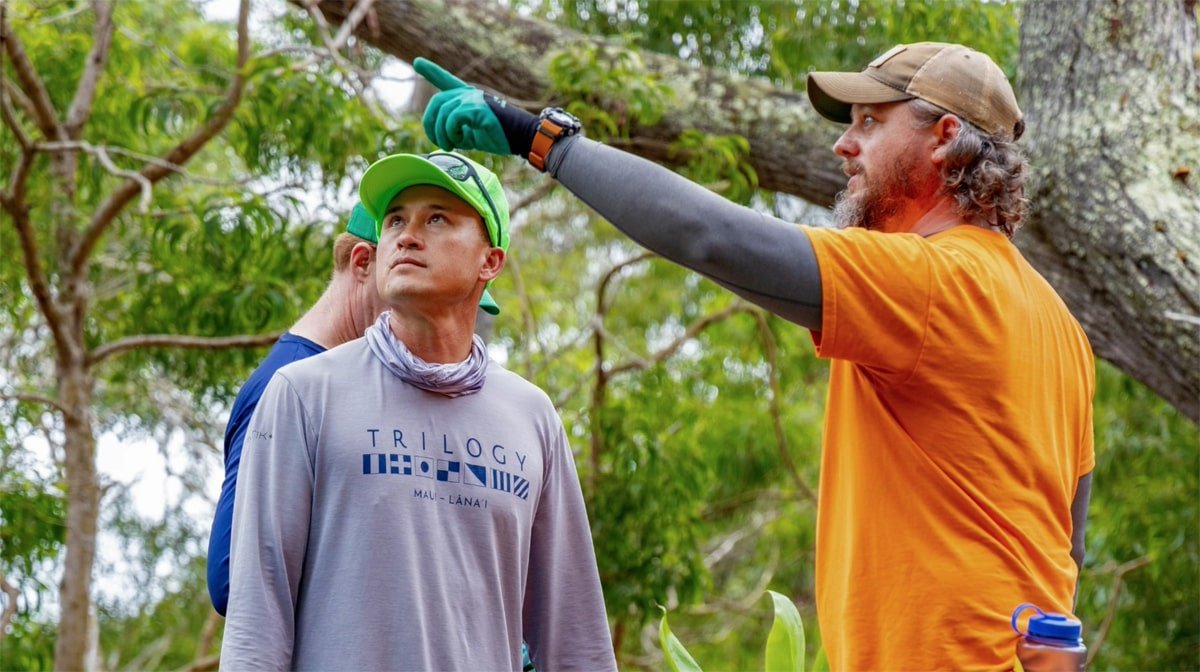Malama Maui County: Trilogy Helps Restore Ancient Fishpond at Waihe‘e and Native Species On Lana'i
It’s no secret that the crew here at Trilogy is proud of the islands we call home.
Which is why, since our founding in 1973, three generations of this family-owned company have worked to malama, or take care of these islands—even in capacities not directly related to our Maui snorkeling tours.
What happens mauka, or upland, on these islands, eventually affects all things makai (by the sea), and it’s important for us as island stewards to look at our Maui ocean activities as part of a greater whole.
It’s also important for our company leaders to constantly connect, engage, and learn about cultural practices, local history, and core Hawaiian values, so we can foster that ‘ike (knowledge) and share it with guests—who are not only looking to go snorkeling in Maui—but also want to develop their own sense of appreciation for these islands.
Over the past couple of months, our Trilogy leadership, customers, and crew had the chance to engage in community projects from the shores of Waihe‘e to the uplands of Lana‘i, which are highlighted below as part of our new blog series, Malama Maui County.
Waihe‘e Dunes Fishpond Restoration
Prior to the arrival of Western explorers, Hawaiians were masters of sustainable harvest and protection of natural resources. Few resources were more integral than fishponds, which were built as part of a community effort, and in turn, sustained the community.
Many of these fishponds were built along the coast, but in places where coastal fishponds weren’t possible (due to deep water or wave-battered shores), Hawaiians constructed loko i‘a kalo, which were inland fishponds that also doubled as lo‘i for for growing kalo (taro).
Though the fishpond in Waihe‘e, on Maui’s northeastern shore, was built in the 1500s, about 120 years have passed since it was actively farmed or used. At peak production, this 7-acre pond could provide hundreds of fish per year and around 10,000 pounds/acre of kalo.
Today, however, it sits in disrepair, with stone walls that have partially collapsed, and a freshwater connection with Waihe‘e Stream still needs to be established.
Building a fishpond requires perseverance (not to mention, strength and patience)—and it also requires a great deal of teamwork. That’s one reason why our Strategic Planning Committee linked up with a crew from Hawaiian Islands Land Trust to help restore and revitalize the fishpond at the Waihe‘e Coastal Dunes and Wetlands Refuge.
Working together over multiple days, the crew (including some third-generation Coon family members) hauled rocks, cleared land, and helped to bring back this ancient resource that not only helps connect us to the past, but still has potential to sustainably feed communities for generations to come.
Malama Lanai Restoration Blue ‘Aina
While the work at Waihe‘e was solely comprised of crew, Trilogy also hosted a Blue ‘Aina event where customers and crew worked with Pulama Lanai to help in restoring native plants on the island’s forested slopes. The event was in partnership with Hawaiian Tourism Authority, as a pilot program for regenerative tourism that helps visitors to the island gain hands-on opportunities to learn, and give back, to these islands.
As part of the Malama Lanai program, Trilogy loaded up 40 guests in Lahaina and motored across the Au‘au channel to the neighboring island of Lana‘i. From there, vans loaded up with visitors and crew headed mauka to get their hands dirty in a misty forest that’s bursting with native koa trees.
Working to help remove invasive plants, volunteers helped fill buckets full of weeds that compete for resources with native species—eventually crowding them out.
As John Sprague—Director of Conservation for Pulama Lanai—passed on to the group of volunteers, rather than being here to “take” from Lana‘i (whether it’s photos, resources, etc.), these efforts are part of giving back, and to restore and revitalize what once was.
The group also helped to plant native species, where hardy roots help mitigate runoff, which in turn, helps keep it off the reefs. This sort of work is a prime example of working upland to care for the sea, and is just one small example of the interconnectedness these programs are meant to highlight.
The group was also given the chance to visit Lanai City, to not only experience the relaxed pace of life in Lana’i’s only town, but also help support local restaurants, shops, and longtime island businesses.
To learn more about future volunteer events and island conservation, Contact Us for upcoming opportunities, or join our mailing list by signing up for our newsletter at the bottom of this page.
Mahalo nui loa to our customers and crew for helping malama Maui County!





